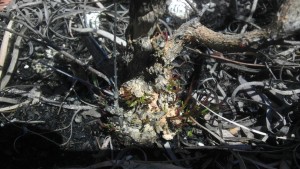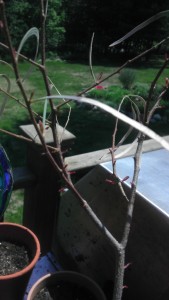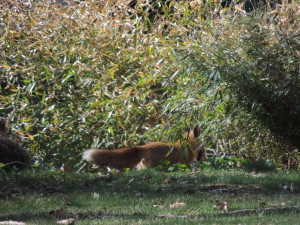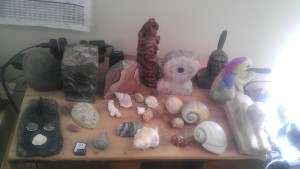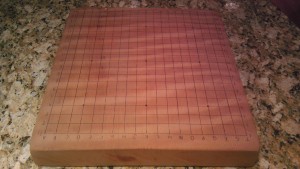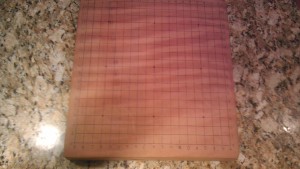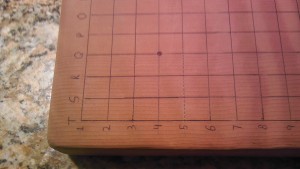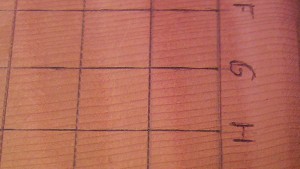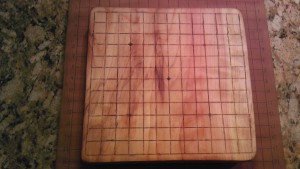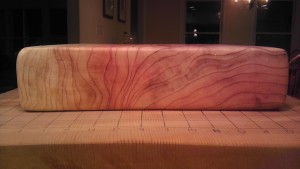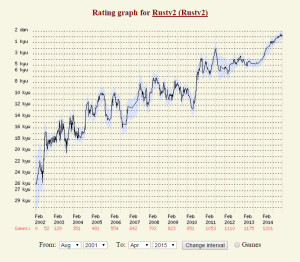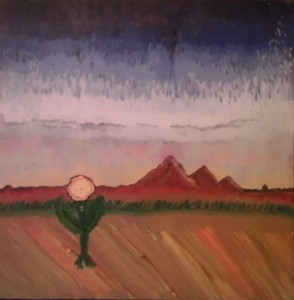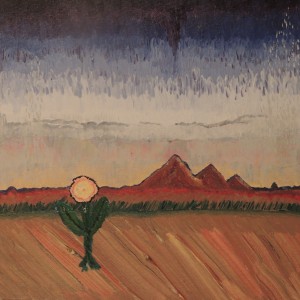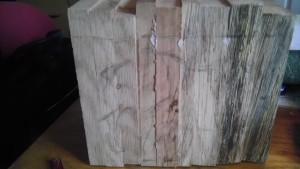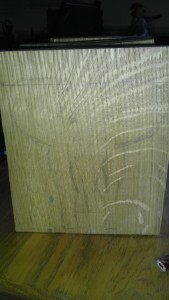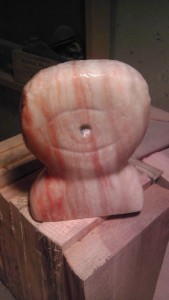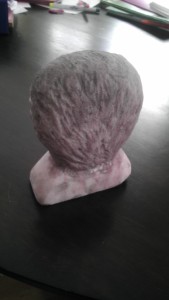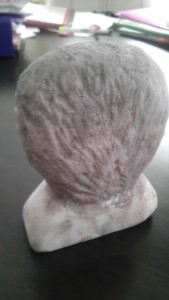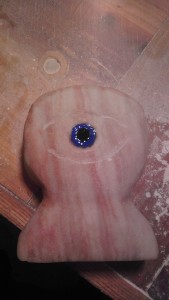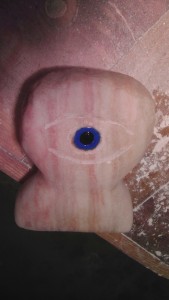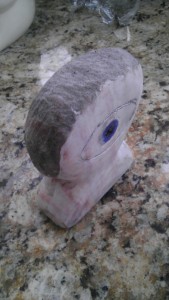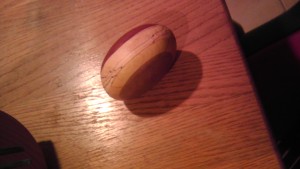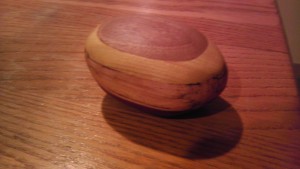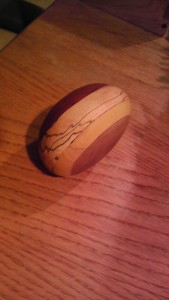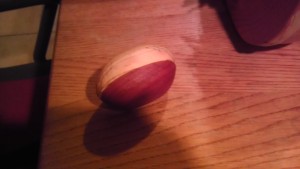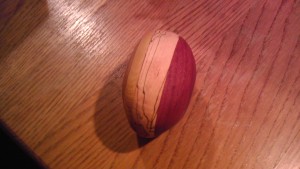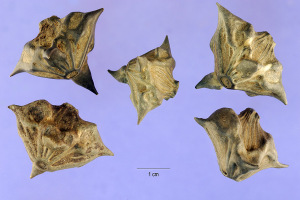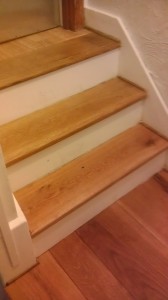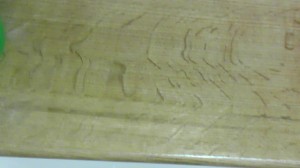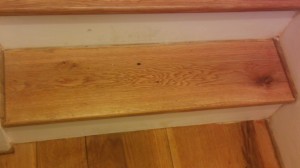Of Solanaceae, my experience with it, permit me to share. Or better yet – of the perfection of a circle, let me speak! – but not really. The Solanaceae family is very large, and in comparison my experience is very small, yet I’ve seen so much that connects the family and its members that speaking of them together unifies what otherwise would seem discordant potpourri.
Tomatoes I never remember disliking. My children liked ketchup but not tomatoes until unexpected mid-adolescent conversions overtook them. For me the first more detailed experience was my mother’s garden where for a few summers in my teens she had an abundance of plum tomatoes growing. For two months of these years there were reliably two dozen or more fresh ripe plum tomatoes on the counter in the kitchen. Being young and starved, although comparatively neutral to tomatoes at the time, I’d have few each day. They were sweet and fleshy and I evolved a game or ritual that caused me to know them much more closely. There were two goals – the first was to peel the skin off with the teeth without tearing the fleshy walls. This was a delicate act. Thoughtless nibbling would quickly fail. I don’t know that I even succeeded once the first year. Eventually I became good at it though, though I’m not sure I could do it forty years later with the same aplomb. The second feat was to then remove the fleshy walls with ones teeth without tearing the center to which the juicy seeds clung. Done properly one would have a little ball of gel-coated seeds, quite a thing to behold in the catalog of idle amusements. Probably it could be the subject of a photo-exhibition and captioning exercise. Here I’ve left some ground for the earnest seeker. It was never more than once a day that I could succeed at both challenges. How one holds the tomato becomes an issue, if the finer points are to be considered, and where one starts. The enhanced vitamin C intake caused by these exercises made them seem very bright.
I’d taken note, but hardly a special note, of the tomatoes flower. Small, white, with a yellow center, five petals. Any special thought about Solanaceae drop out here until my first shots at gardening, where peppers were a favored subject. By this time the internet had been born (not so in those early days) and one could gather all sorts of mostly true information and connections to persons who knew some things and from them obtain seeds. I had seeds of rocoto and fatalii and a Jamaican purple Habanero that I spent six years growing and have not since been able to find. The first year, observing the peppers grow, and seeing their small white five pointed flowers, and then considering their flesh, the thickness of their walls, the way that the seeds clumped and clung to the center, it was obvious to me that tomatoes and peppers were cousins – and the thing is, you don’t have to believe it – I did not read this, it just occurred to me. That’s something I so love about nature, that just by seeing one can gather so many true and meaningful associations.
The purple Jamaican Habanero – maybe it was not Jamaican – has a flower that can be white and purple, small and five pointed. The leaves are dark green/purple. The fruit is initially purple and stays purple and is quite edible that way until it approaches final ripeness where it turns a blazing red. The heat of these was hot for other peppers but not for the Habaneros of modern times. It’s no ghost pepper or deadly scorpion or Comet Kohoutek pepper, for that matter. Very good chopped into a fish salad. I grew them in pots and would take them in for the winter. Doing this led me to discover how profoundly solanum attract aphids. I have pity for aphids when I hear the tales of their being cruelly farmed by ants. I’ve stumbled upon and watched such enterprises – I suppose it’s a symbiosis but not one I’d want to be part of on either side of the deal. Anyway the overwintering rate the first years was perhaps three of ten, and the ones that survived just barely. I don’t use poisons but will manually crush dense clusters of the aphids – perhaps I’ll spray soap, rinse them, but I’ve never really squelched and aphid infestation as effectively as putting them outside and letting natural predators do their job. Ladybugs. One year I was living mostly in a hotel in Syracuse. I’d had one of these plants in the suite I’d been given. Miraculously that year there were no aphids. It did well indoors in the fall and winter and when Spring came I asked the hotel staff if they’d plant it in their garden out front. Never have I seen a pepper do better. Daily care – a hundred fruits at least, and very beautiful with the green purple and red at ripeness. I picked bowls of them for the unwitting guests. These purple ones I kept around for several years but after a while one winter I was not quick enough in the face of the frost. I should have been more thoughtful about saving the seeds. My first excellent specimen below, a really beautiful plant.
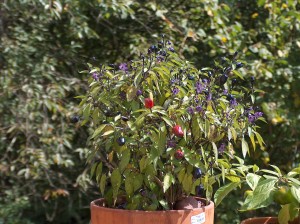
Of the rocoto in particular I must make a few remarks. It has the thickest walls of any peppers I’ve known. The seeds are black, also unique to them. The leaves are hairy. Capsicum Pubescens, that’s how it got the name. The heat of it is quite variable, gong from a low 7 to a mid 9 (for me 10 is 100K Scoville – anything more I’d put in the genre of stunt pepper). It’s flowers show a little purple sometimes. It has a quite different flavor, as peppers go, well worth growing. I grow these every several years. They have a long season not always fit for us north of Boston, in fact, I’ve never had them fruit unless I’d overwintered them. Were I truly thoughtful I suppose I’d start them indoors in new soil in January and thus thwart both the aphids and the shortness of light, but the ‘were I truly thoughtful’ is always chock full of rich possibilities. Dicing a few of these into a Thanksgiving turkey stuffing or incorporating them into a tomato/pepper base for a slow cooked short rib stew will certainly find admirers.
Here’s a picture of one of the first ones I grew. The peppers themselves from this plant will eventually turn a wonderful red. Other rocotos go out toward yellow or orange.
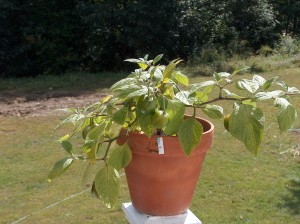
The Fatalii seems to be an African habanero, yellow, quite hot, with a flavor diverging from the standard habanero. One year I was able to grow these, seven peppers in all, to fruit in the same season as they sprouted. I made a hot Thai ginger scallop thing with them, snow peas too, a little coconut milk. I’m sure there’s a lot one could do with them. I now buy a puree that available of Fatalii only. Makes me lazy (as far as struggling to grow them).
Alright, so that’s the run of the mill. Remember the small five pointed flower and the fleshy walls and the seeds that cling to the center, sometimes dry and sometimes with gel? Walking around the yard it became clear to me – actually I first noticed it in potted plants I’d brought in for the winter, that there were these little tomato cousins, with a fruit the size of a pea, dark purple/black, born in little clusters of three to five. I squeezed one of the fruits and indeed, little gel coated seeds, fleshy walls – the joy of observing nature. Was it edible? Research research research – I know the solanaceae family has many poisonous branches (no pun) – mostly it’s solanine. It’s what makes green potatoes – oh, did you know, potatoes too are solanaceae – poisonous, but as they ripen the solanine somehow transforms into something else or otherwise diminishes and they’re just fine. Tomatoes were thought poisonous. Of course this family too produces many utterly discombobulating alkaloids that no sane person would ever choose to court. The name nightshade and all – that’s what Solanum means in Latin. Solanum nigrum is what these little black fruits were from – black nightshade. The thing is that most people don’t know that these guys are just fine to eat if they’re ripe, and they’re delicious, tangy skin, sweet flesh. I’ve subsequently bought (over the internet) preserves made from them in Idaho. One day I’ll make my own, given time and grace enough. They’ve been called huckleberry, wonderberry, sunberry – great controversy arose in the early part of the twentieth century about whether they were the purposeful hybridization of a Luther Burbank or just a weed. Known in Hindi as Manatakkali. Every year five or ten of these will self seed somewhere at the edges of my gardens. I incorporate them in my harvest vegetable stew.
The hooded ones. Here we drift over to the physalis branch of the solanaceae: Tomatillos, Chinese lantern plants and the cape gooseberry. Tomatillos are sour and slimy but they will grow in great profusion and supposedly add character to chili and other dishes. I grew them for several years, the green and purple and even a yellow kind, and attempted every kind of redemption I could conceive. Turkey tomatillo meatloaf? Tomatillo parmigiana (a la eggplant parmigiana – (you know the eggplant is yet another solanum)) but I have to say that even the a la eggplant parm approach, which would probably make cow flops pretty tasty, did not do so much for the tomatillo. The best was the chili verde angle with pork tenderloin – it’s not that they are still not slimy and sour, but it’s a little tanginess and thickens the liquid. Perhaps diced into ceviche? The cousins, the Chinese lantern plant for example, those berries are edible, but like the cape gooseberry aka peruvian goldenberry aka … I put those in the harvest stew when we grow them. The physalis peruviana is a lovely plant. The leaves can be hairy. Without aphids it would winter very well. The fruits are sweet and a little bit tart. I think I great pie could be made from these – I’ve had a preserve made from Hawaiian grown versions – I think they call it the poha there. Part of the familial relation between these solanacae is illustrated by this observation. One year I grew potatoes from cut up red potatoes I’d bought at the supermarket. The next year though it seems like potato beetles got wind (really) of my potato plantings and came and decimated the plants very early. Having done too good a job there they adopted the phys perviana – which was both a joy to see how the bug showed that these plants leaves taste the same and sad, of course, because what otherwise would have been a bumper crop of gooseberries was also destroyed.
Here, in succession, are pictures of an alluring cape gooseberry at dusk, a ravaging potato beetle on a gooseberry leaf, and a small chorus of ripe cape gooseberries, just before they begin to sing.
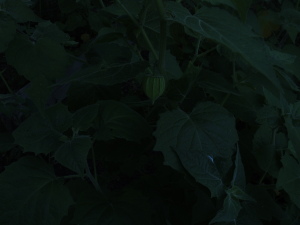
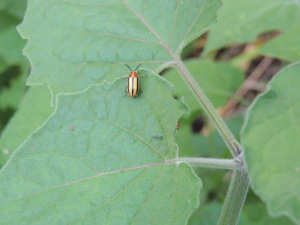

Before I get to the wonders of the kangaroo apple, I must first report on the sad frolics with the Tree tomato. This really is just more of a tale of unrequited desire. To keep it to the point, as this whole ramble is getting to have too many arms and legs, I’d always wanted a tree tomato, just because ‘how cool is that?’ – tomatoes, or almost, that grow on trees. Tamarillo seems to be what they are called, Solanum betaceum for you who are more formal, Tammy or Bettay for street dealers. I’ve ordered mature plants only to have them freeze on my doorstep, ordered seeds that seem never to grow. It’s not that ultimately there is anything so exotic about these, it’s just one of those things at the edge, wanted but never seen, chased but never overtaken, etc.
In March of 2009, at the Pasifika Festival in Western Springs Park in Auckland, I was very attentive to the flora, alert for things I’d never seen. After some browsing about I came across a bushy eight foot tall thing with purple branches and yellow cherry-tomato-like fruits. I quickly jumped to the conclusion that this must be an example of the tree tomato (tamarillo) that New Zealand had been trying to turn into a commercial crop for some time, so eagerly I took two of the fruits. I kept them on the counter in my apartment in downtown Auckland and watched them turn a rich orange as they ripened. After two weeks or so I sliced them open and indeed they were constructed just as tomatoes are, so I was confident of their identity. I let the seeds dry between a few papers in a notebook and eventually (accidentally) brought them back to America.
In June of 2009 I sowed them and 25 or so seedlings quickly sprouted. There was a bit of a heat-wave that July that killed the less hardy but I still had ten or so coming into the autumn. A few I gave to plant oriented neighbors, one to my mother and one to my sister, one to Maeve’s school and three I kept. Over the winter, in the dryness of the cactus room, they developed a nasty case of spider mites and I had to poison them several times to preserve their life. They came through into the spring just barely alive. I set them in the ground in late May and (it was very warm) they took off, growing new stalks, flowering, beginning to bear fruit. It was then that I had to address a nagging doubt, that despite the obviousness of the call that they were tree tomatoes, their leaves shape and flower color did not at all match the pictures of tree tomatoes I’d seen on the internet. I took a picture of one and sent it to an old woman I had met in New Zealand, and she confirmed indeed that these were not tree tomatoes, though she did not know what they were, though some grew near her house and she said she could find out but the thought they were poisonous. This confirmation goaded me to search the internet more vigorously for what they might be. Turns out the colloquial name is ‘Kangaroo Apple‘ – a.k.a. “New Zealand Nightshade”. Nightshades are funny plants, as are potatoes, being quite poisonous when green but entirely benign when ripe. It is said that Australian aboriginals quite like these kangaroo apples – and of course they’re smart enough to wait to eat them till they’re ripe. I tried a few in a salad – not exactly my thing, but bless biodiversity.
This aviculare also proved to be a trifle hardier than I expected – not that they could withstand the northern winters here – but one seed did sprout from a fruit that nust have fallen the previous year. Right now, at the end of 2014, is the first year I’ve been without them sonce that 2009. I recommend them as distinctly fun if you like watching plants grow. Especially the immature leaves, they have different shapes than the mature ones, almost like fingers on a hand. Immediately following are pictures of a young one flowering one with fruits on the branch, and one selected by a beetle.
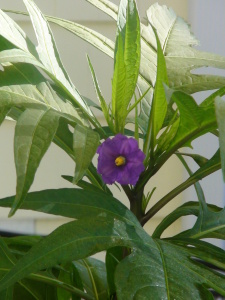
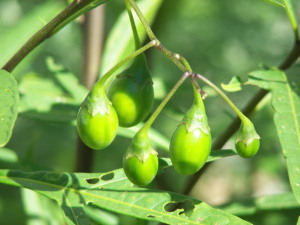
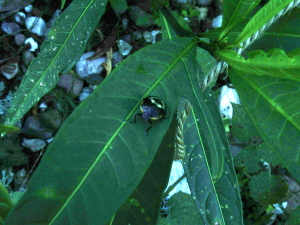
A few of the less common (upper here in the northeast of North America) solanace I’ve grown are lulo and pepino. Lulo – Solanum quitoense, also naranjilla, has some of the most beautiful leaves I’ve seen. A real delight to watch it grow. In three years though my three plants have never flowered, I guess i’m not puttng enough care into their care. The lulo is supposed to produce a fruit with a citrus flavor, despite not being of the genus citrus. The pepino (Solanum muricatum) is supposed to produce a fruit that is like a pear and a melon all at once, despite being a cousin of a tomato – I think this might be a good aspersion – “You cousin of a tomato!” – yet, like the lulo, for me, this plant has proven unvigorous, susceptible to pests, disinclined to bear flower or fruit. I’ll probably grow them till I get a fruitful outcome, but the journey will be far longer than I’d prefer.
A Lulo leaf below. Some have thorns, some do not.

On the other side, quick to grow and fruit, three I can discuss. One year I ordered as many different kinds of solanum seeds as I could find from the internet. There were turkey berries, indian eggplants, I can’t even remember the many others. As with eucalptyi I lose track of the which is which with astounding reliability. Anyway one of these, I’m not sure which it was was deemed a no no by the US Agriculture Police. They actually came to my home because they had observed that I had bought one on the internet. I think the problem was that if released into the wild it was very invasive – I’d bought monster seeds! Now inasmuch as I lose track of which is which I did my best to point out which the offending spawn was, and the good news is that I’ve had no outbreaks of evil plants, but the whole thing was strange. All sorts of plant material moves on thousands of channels all around the world. I certainly would not want their job.
Speaking of nasty solanums though, if you meet a Carolina Horsenettle (Solanum carolinense), do not indulge it. I saw a few of these a few years ago at the edge of the woods in Fairmont Park. I knew they were Solanum of some sort. Short and thorny with orange/yellow cherry tomatoes on it. Poisonous by every account. And tenacious- once you get a few growing they are not easly removed, as they propagate from their own roots, and so, unless fully dug out or poisoned hey will multiply.
The other nasty one, not because it’s invasive but because of it’s prickliness and poisonousness, is the porcupine tomato, Solanum pyracanthon. It’s actually a delightful plant to grow, very vigorous, very beautiful – just don’t touch it or eat it, and all will be well. Watching them grow, especially for the first time, is quite a thing.

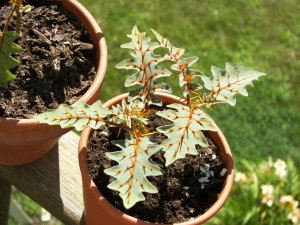
I’ll close with one that sounds nasty but in fact has behaved very well – the cannibal tomato, Solanum Uporo. As of December 2014 Wikipedia does not even have these yet. They are from Fiji, are very like a tomato, are bitter, were supposedly favored by cannibals for adding to a happy homo sapiens stew. I’ve grown them a few years, have not even gone so far as to try them with pork.
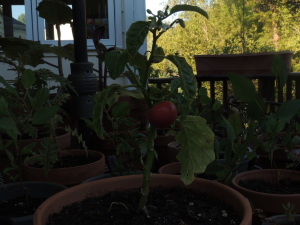
So there you have it, and thank you for your great patience if you’ve waded through all this. This family of plants does fascinate me and with sufficient grace I’ll experiment much further with them. Mostly though, it’s not even the prospect of what may be done but rather a sense of thankfulness at the wonder of them, that they are some sort of family growing in this tremendous diversity of ways across all of earth’s many environments and adapting to the presented conditions with such creativity. Pretty awesome to me.

